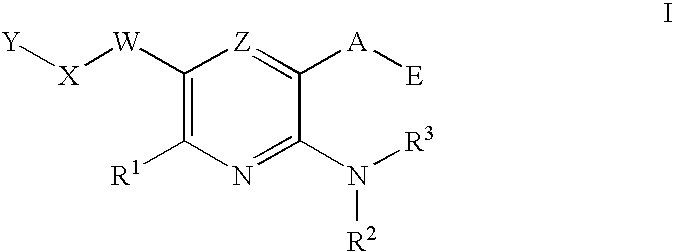Protein kinase modulators and methods of use
a technology of protein kinase and modulator, which is applied in the direction of heterocyclic compound active ingredients, biocide, drug compositions, etc., can solve the problems of poor prognosis, inducing apoptosis (programmed cell death), and correlating the level of cyclin
- Summary
- Abstract
- Description
- Claims
- Application Information
AI Technical Summary
Benefits of technology
Problems solved by technology
Method used
Image
Examples
example 1
3-amino-6-phenyl-N-(phenylmethyl)pyrazine-2-carboxamide
[0357]Methyl 3-amino-6-bromo-pyrazine-2-carboxylate: Commercially available methyl 3-amino-pyrazine-2-carboxylate (available from Aldrich Chemical Company) was brominated using a procedure similar to that of Russ, T., Ried, W., Ullrich, F., and Mutschler, E. Arch. Pharm. (Weinheim) 1992, 325, 761-767. To a solution of methyl 3-amino-2-pyrazine carboxylate (30.0 g, 200 mmol) in acetic acid (200 mL), bromine (11 mL) was added slowly via addition funnel. After complete addition of bromine, sodium carbonate powder was added slowly until precipitation occurred. The reaction mixture was allowed to stir at room temperature for 2 h. The reaction mixture was reduced to half-volume in vacuo and then diluted with water (500 mL). The reaction mixture was shaken vigorously and the resulting solid was collected using vacuum filtration. The solid was washed with ether to afford a pure yellow solid (91% yield).
[0358]Methyl 3-amino-6-phenylpyraz...
example 2
3-Amino-6-naphthalen-1-ylpyrazine-2-carboxamide
[0373]Methyl 3-amino-6-naphthalen-1-ylpyrazine-2-carboxylate: To a solution of methyl 3-amino-6-bromopyrazine-2-carboxylate (0.18 g, 0.74 mmol) in N,N-dimethylformamide (10 mL) were added [1,1′-bis(diphenylphosphino)ferrocene]dichloropalladium(II) complex with dichloromethane (1:1, 60 mg, 0.07 mmol), 1-naphthylboronic acid (0.32 g, 1.89 mmol), and triethylamine (0.15g, 1.52 mmol). The solution was degassed with nitrogen for 3-5 min. The reaction was then heated to 85-90° C. overnight. The reaction was cooled to room temperature and diluted with ethyl acetate (300 mL). The crude solution was passed through a pad of silica gel under vacuum. The filtrate was washed with saturated aqueous sodium bicarbonate (50 mL) and saturated aqueous sodium chloride (50 mL). The organic layer was dried over magnesium sulfate, filtered and concentrated at reduced pressure to afford impure product. Column purification on silica (8:2 hexanes / ethyl acetate) ...
example 3
3-amino-N-methyl-6-[4-(tetrahydro-2H-pyran-2-yloxy)phenyl]pyrazine-2-carboxamide
[0410]3-amino-6-bromo-N-methyl-2-pyrazinecarboxamide: An ice-cooled solution of 50 g of methyl 3-amino-6-bromo-pyrazine-2-carboxylate in 500 mL of MeOH was saturated with methylamine gas. The reaction was then heated at 85° C. in a sealed, stainless steel Parr pressure vessel for 2 h, and cooled to room temperature, and then on an ice water bath. The mixture was concentrated to an oil on a rotary evaporator under reduced pressure. The crude oil was dissolved in EtOAc and washed with water, dried (Na2SO4), filtered, and concentrated to give 43.9 g (88.0% yield) of product as a solid.
[0411]3-amino-N-methyl-6-[4-(tetrahydro-2H-pyran-2-yloxy)phenyl]pyrazine-2-carboxamide: A suspension of 3-amino-6-bromo-N-methyl-2-pyrazinecarboxamide (69.3 mg, 0.3 mmol), [4-(tetrahydro-2H-pyran-2-yloxy)phenyl boronic acid (111 mg, 0.5 mmol) [1,1-bis(diphenylphosphino)-ferrocene]dichloropalladium(II) complex with dichlorometh...
PUM
 Login to View More
Login to View More Abstract
Description
Claims
Application Information
 Login to View More
Login to View More - R&D
- Intellectual Property
- Life Sciences
- Materials
- Tech Scout
- Unparalleled Data Quality
- Higher Quality Content
- 60% Fewer Hallucinations
Browse by: Latest US Patents, China's latest patents, Technical Efficacy Thesaurus, Application Domain, Technology Topic, Popular Technical Reports.
© 2025 PatSnap. All rights reserved.Legal|Privacy policy|Modern Slavery Act Transparency Statement|Sitemap|About US| Contact US: help@patsnap.com



